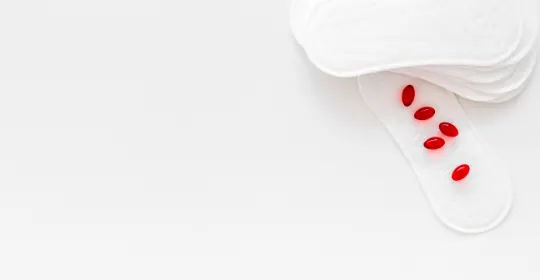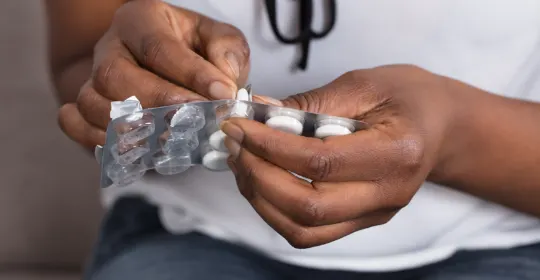Spotting Instead of Period: Causes, Symptoms, and How to Manage It

Over the course of a menstrual cycle, a woman gets her period, typically, for around three to seven days in a month. This is a normal and healthy bodily function that is considered routine and nothing to be alarmed about. However, some women may at times also experience some spotting outside of their period bleeding days. Note that this is common among many women and there are many reasons behind it, the most common being ovulation period bleeding or slight bleeding during ovulation. In most situations, it is simply shedding of the uterus to stay healthy and not always a cause for concern. If you experience spotting, we'd recommend you use a mini pad or a panty liner to manage the discharge from spotting.
The important question, however, is how does one differentiate between spotting and menstruation? To better understand this distinction, we have listed a few pointers below.


Decoding the difference between spotting vs period
- Spotting is usually characterized by very light bleeding. It is a light-coloured fluid that is discharged mid-cycle or between the days of menstrual periods
- Menstrual period is the heavy flow that women experience to prepare for a possible pregnancy
- Spotting can be triggered by several underlying causes. It must be specially brought to the notice of the medical practitioner if it happens during pregnancy
- While menstruation usually happens around the same date every month (i.e., the menstrual cycle), spotting can happen unexpectedly


Symptoms of a period
- Before and during your period, you will experience the following symptoms.
- Cramps or ache in the abdomen and lower back
- Feeling heavier and bloated
- Fatigue and nausea
- Recurrent mood swings
- Headache
- Soreness in the breasts
To manage your period, use Always sanitary pads for the best period protection. The Always Ultra Thin pads are an ideal fit as they are designed to have a Super Absorbent Core with InstantDry System that absorbs wetness in seconds. It also has a Clean and Dry top cover that ensures long-lasting dry comfort, even on heavy flow days. Made with Supreme Quality material and design, they offer for maximum safety and upto 100% comfortable protection.


Symptoms of spotting
Spotting can happen during your period or at other times of the month. Some of the signs of spotting include:
- Itching around the vagina
- Slight redness in the vagina
- Pain during sexual intercourse
- Vaginal discharge coupled with odour
- Weight gain
- Irregular periods


When is spotting likely to occur
You may experience spotting more recurrently during the following spans:
- A few months before approaching menopause
- When using birth control pills or switching between birth control pills
- During pregnancy
- Being affected by polycystic ovarian syndrome (PCOS)
- Being affected by sexually transmitted diseases (STDs) or vaginal tract infections
What is Ovulation Period Bleeding?
Ovulation, typically occurring midway through the menstrual cycle, involves the release of an egg from the ovary. Some women may experience minor bleeding or spotting during this time. Ovulation period bleeding refers to this phenomenon, which is often characterised by light bleeding or the presence of brown discharge.
Certain individuals experience slight bleeding during ovulation. This can be attributed to the rupture of the follicle, releasing the egg. While not every woman experiences this, it's a normal variation and may manifest as a few drops of blood or pink-tinged discharge. Brown discharge during ovulation is another common occurrence. This type of brown discharge observed during ovulation is typically older blood that has taken longer to exit the body, often appearing brown or dark in colour.


Managing spotting and periods
Now that you know the difference between spotting and periods, it is important to manage both these conditions differently and effectively. Use high-quality sanitary pads from ALWAYS to soak up the heavy period flow. You may also opt for tampons if you wish. On the other hand, pantyliners which also work as a mini pad are your best bet for managing spotting as the flow is much lighter and does not require a thick absorption core.
Tracking your period cycle will help you understand if the bleeding is a result of menstruation or spotting. Use the ALWAYS Period Tracker to keep tabs on your periods and evaluate what is normal for your body as you experience more period cycles. It will then be easier to tell if something is amiss down there. In such a case, you should consult your doctor immediately.
Keep a track of your ovulation period with Always Ovulation Calendar and Period Calculator.
Looking to manage your period cycle better? Our guide shares practical tips on how to end your period faster that you can try today.
Disclaimer
Please note the date of last review or update on all articles. No content on this site, regardless of date, should ever be used as a substitute for direct medical advice, diagnosis or treatment from your doctor or other qualified clinician. Always is committed to ensuring that all of our products meet rigorous safety standards; Always pads prioritize safety, protection and comfort of its consumers.










